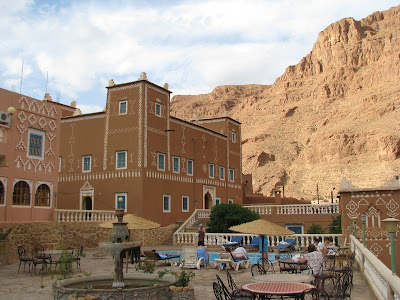 |
| Hotel Taborihte Todra Gorge |
One of the exciting opportunities we had whilst travelling in
Morocco was to sample a variety of accommodations. Most were family owned, recently restored and
always worlds away from the Hyatt experience.
Yes, sometimes the hot water was cold, occasionally we had squat toilets
and there were often lots of dark stairs to climb but the terraces offered
wonderful views over busy medinas or dark desert skies filled to the brim with
stars.
 |
| Hotle Majestic, Meknes: we might have to re-reno the reno's at home. |
We had been told it is not in the Moroccan character to
compete or be showy with wealth. When it comes to their home, exteriors are
kept plain and simple and do not indicate family size or wealth. Doors are large often with two openings; one
larger to receive important guests and a smaller one for family members,
obliging a respectful bow on entering the household.
 |
| Hotel Al Mamoun, Casablanca: very central |
Once inside, rooms and narrow passages seem to multiply; a
labyrinth and hive of family activity, including perhaps granaries and stables
– if you were a king or noble! Few have
external windows as a courtyard, perhaps with a cooling fountain and/or garden and
intricate tile-work, clearly defines the central hub.
 |
| No photo of Jnan Sbile in Fes, so colourful tileworks instead |
Colours vary; some are bright and enthusiastic, others are
charming blue and white. Ochres define
mud brick constructions which range from simple walled gardens to huge
fortresses. Low brown Berber tents are
stretched with hide and provide shelter from scorching desert heat.
 |
| Maison d'Hote La Fibule: Action Houssain offers wonderful accommodation |
Riad: Riad
literally translates as “garden” and they were traditionally built as a
nobleman’s townhouse, often for reception or business purposes. Built around a central garden, a riad provides
the family with an escape from outside medina bustle. The garden usually has olive, orange or palm
trees, perfumed plantings and a central fountain. Houses often have less than 12 rooms, are
colourfully decorated and often come furnished with antiques or stylish local
products. Many are being renovated and
offered as B&B accommodations, particularly in Marrakesh and Fes.
Dar: Literally
translates as “house”. Generally we know
it as a traditional townhouse with internal courtyard, sometimes enclosed.
 |
| Riad Dar el Qdima, Essaouira: Kitchen servery |
Gite (said
zheet): A gite is traditionally a rural holiday rental. Usually a renovated traditional cottage, they
offer rudimentary accommodation (a trekker’s hostel) or sometimes a homestay.
 |
| Gite Imin Tzlkert, Aremd: family-run gite with view of Jebel Toubkal |
Auberge: From the
French, literally translates as inn or tavern. The Auberge we stayed in was a
rambling collection of rooms around various courtyards. It spread over quite a large land area. Needless to say, it was in a rural setting on
the outskirts of a small village. Auberge
Jaafar, located near Midelt, was surrounded by orange, walnut, almond and olive
trees. Here we were entertained by a
Berber troupe
 |
| Auberge Salama, Merzouga |
Ksar: A Ksar (singular)
or Ksour (plural) is a fort or
fortified stronghold often made of pise (sundried clay or mud) and sporting
battlements and bastions. This is
another construction of featuring a labyrinth of rooms, passages, streets and
souks. We had the pleasure of seeing
two, Ait Benhaddou (the setting for Lawrence of Arabia) and El Korbat, where
they have a small but interesting museum.
Even if you aren’t keen on museums, this little gem gives you a
fantastic opportunity to get lost inside a real Ksar.
 |
| A crumbling ruin. Most prefer modern accommodation now |
Desert Camp:
Traditional nomadic Berber-style accommodation for families. A camp consists of low, brown tents made of
waterproof hessian type cloth or animal hide sited for protection. They are furnished with basic mattresses and
blankets. We had a generator for
lighting at night – quite a luxury!
Azib: An azib is
a seasonal shelter used by Berber shepherds when tending their roaming
flock. It is usually a modest tent,
little furniture (if at all) and can have an internal fire or stove.
Medina: The old city or town, usually enclosed by
a fortified wall. Filled with a seeming
chaotic collection of housing and souks that run along a labyrinth of narrow
streets.
Mellah: Jewish
quarter of the medina
 |
| Hotel Caspien, Marrakesh: Foyer |














































